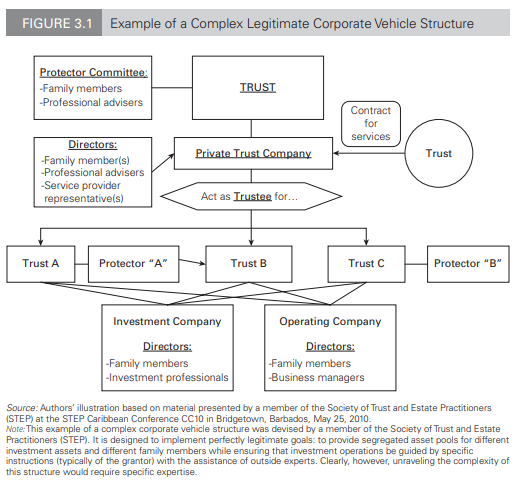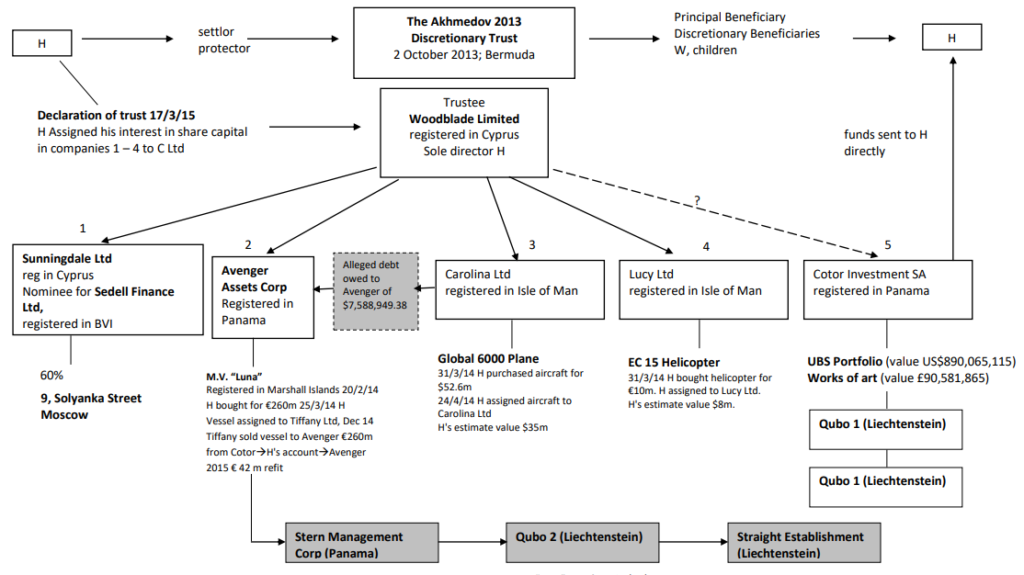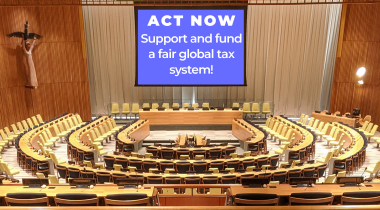
Andres Knobel ■ Regulating complex ownership chains – a call for experts for closed brainstorming round-table session

Regulating complex ownership chains – A common goal for tackling beneficial ownership transparency and tax avoidance?
The Tax Justice Network, together with City University London, the Independent Commission for the Reform of International Corporate Taxation (ICRICT), Transparency International and the Financial Transparency Coalition are co-hosting a closed brainstorming round-table on 6 October, from 2 to 4 pm London time to discuss the risks of complex ownership chains and how to address them.
Participation is by invitation only, but if you think you have good ideas to answer the questions below, please write to [email protected] and we will consider your participation based on the number of attendees, and the relevance and diversity of expertise and opinions.
This roundtable invites experts to start thinking and finding answers to questions at two different levels: the ideal long term scenario and measures that could be taken faster.
A. The ideal scenario for the long-term:
- Do complex corporate structures (many layers and many different types of legal vehicles) offer any benefit to society that cannot be ensured in any other way? Do these benefits outnumber the secrecy risks?
- What is the bare minimum legal structure needed to engage in a specific business or endeavor and what does it depend on? For example, to ensure limited liability an individual would need to set up at least one company. Are there similar legitimate “benefits” or “results” that can only exist when two or more legal vehicles interact with each other? For example, an entity may be required to establish a subsidiary or branch in a foreign country to sell goods or services or to acquire assets in that country, but is there a legal requirement or business purpose that can only be met by establishing more than one subsidiary/branch in that country?
- Would complex groups (especially those where the complexity is the result of organic growth of acquiring other firms) choose to simplify their structure if the simplification process was free, or even then would they prefer to stay “complex”? In other words, do complex groups stay complex because it’s too costly to simplify or do they obtain a benefit from being complex?
- Does the complexity depend on “legitimate” factors, eg presence in different countries, goal to sell business units, number of employees or income? Should there be different regulations for listed or unlisted companies, active or passive entities (those engaging in business vs those merely holding assets) or by economic sector; or is there a one-size-fits-all approach?
- Would regulating corporate complexity (especially vertical length) address only transparency risks, or also tax abuse risks? Does tax abuse depend more on horizontal expansion (having many subsidiaries engaging in different activities, at least on paper), but not necessarily on long vertical chains?
B: Partial measures to implement in the short-term:
- What limits on the ownership chain would be easier and better to implement: limits on the length (number of layers) or quality (only allow entities that had to disclose their legal and beneficial owners)?
- Should regulations: (i) prohibit complex structures (eg more than 3 layers), (ii) discourage complexity by adding more requirements for complex structures (eg higher regulation, more bureaucracy, additional verification steps, etc), or (iii) should regulations simply require a commercial justification (to be challenged if not convincing), by shifting the burden of proof on the company, as a way to obtain an understanding by authorities on the complexity of the legal vehicles operating in their countries?
- How could authorities identify and analyse the ownership structures of the legal vehicles operating in their territories? Should complexity and the length of the ownership chain be considered in absolute terms (eg longest number of layers within a group), or in relation to firms of the same size or sector, or in relation to the total number of subsidiaries within the group?
- For regulatory purposes, what other factors would be relevant to assess (and eventually regulate or limit), in addition to the number of vertical/horizontal layers: nationality of legal vehicles integrating the ownership chain, nationality of beneficial owners, shareholding structure (eg 50-50% vs 99-1%)?
- How could ownership chains be assessed or limited given that corporate groups may hold interests in other groups as portfolio investment? Should this be limited, eg by requiring that any portfolio investment be held directly by the ultimate parent or by a special subsidiary called “portfolio investments in other non-related companies”? or should the regulation on length of the ownership chain affect only shareholders that own more than 10% (or any threshold)? In other words, the limit on the vertical chain would only apply to what would be considered the core ownership of a company or group, but not to minority investors. Or would this be too difficult to implement in practice or would this create loopholes that could be exploited? If imposing such a limit involved the divestment by corporate groups from their holdings in other groups, would that be beneficial because it would de-concentrate the economy? Or it would be damaging because it would lose financing opportunities?
Background
Individuals may set up a wide variety type of legal vehicles to operate in the economy: companies, partnerships, trusts, foundations, anstalts, cooperatives, etc. They may use them to provide goods or services, concentrate wealth, hold assets, protect vulnerable people, invest money, fund charitable causes, etc. They may also abuse those legal vehicles for illicit financial flows.
A legal vehicle in itself may present both secrecy and tax abuse risks. On the one hand, a company that doesn’t have to disclose its legal and beneficial owners, that uses nominee directors and shareholders, or that has issued bearer shares would create secrecy risks. On the other hand, a “hybrid” entity that exploits different tax rules, eg being considered tax transparent in country A but not in country B, or that manages not to be tax resident in any country at all, would create tax abuse risks.
Both risks may be exacerbated by its complex ownership chain: by either (i) adding many more layers between the entity and its beneficial owners, or at least up to the ultimate parent entity; (ii) employing exotic and secretive types of legal vehicles (eg discretionary trusts, anstalts, etc), or (iii) having many entities or subsidiaries engaging in different activities, at least on paper (treasury, finance, research and development, production, etc.)
In most – if not all – countries, individuals are free to set up any type of legal vehicle using as many layers as they please. For example, even the World Bank/UNODC StAR famous 2011 paper “The Puppet Masters” described the following structure proposed by a member of the Society of Trusts and Estate Practitioners (STEP) in Barbados as “an example of a complex structure that is nonetheless perfectly legitimate”:

This structure, as any one, is likely legal. But is it legitimate? Is it really the case that “investing assets for different family members guided by specific instructions” can only be achieved by using these complex structures that create obvious secrecy risks? (Consider that this was proposed in 2010, way before any country had a beneficial ownership register for trusts).
The more layers up to a beneficial owner, the harder it will be to confirm who that beneficial owner is. Even if the beneficial owner is known at a specific time “today John is the beneficial owner of company A because he owns company D, which owns company C, which owns company B, which owns company A”, it is almost impossible to verify that the information is still updated, unless there is real time information about all changes affecting any of companies in the ownership chain (in the example, on companies B, C and D). The risk of long ownership chains is very real. One research into procurement companies in the Czech Republic found that some of the awarded contracts were given to companies with 20 layers of entities up to the beneficial owner. Likewise, the Tax Justice Network analysis of UK companies’ ownership structures revealed that one company had up to 23 layers up to a natural person. When that company’s information registered at Companies House was checked, it was revealed that they had registered contradictory as well as wrong information (eg informing a company as a beneficial owner).
Complexity doesn’t involve only transparency. The liability and asset shielding available to the different types of legal vehicles and their foreign presence may affect enforcing the law or a judgement despite knowing who the beneficial owner is. So far in the highest-stake divorce case in the UK, the former wife of Russian oligarch Farkhad Akhmedov’s (one of Putin’s allies) has unsuccessfully tried to collect her awarded £453 millions after the husband’s assets were moved into newly created trusts and anstalts.

Likewise, many (or most) multinationals are suspected of engaging in tax abuse to exploit different tax rules and other arbitration situations to minimise their tax liability against, at least, the spirit of the law. For example, one the tax schemes involved in the LuxLeaks scandal showed three different layers of companies in one jurisdiction, eg company “LuxCo 1”, owning “LuxCo 2”, owning “LuxCo 3” which in turn owned “LuxCo 4”.

It is not clear whether that structure is used to exploit some tax treaty or other tax arbitrage or if it is completely unrelated to tax but aimed at other goals. However, given that some well-known tax schemes, eg the double Irish-Dutch sandwich involved many different legal vehicles within a multinational, it can be assumed that tax abuse strategies depend on having some complex structure involving more than one legal vehicle (although it is not clear if tax abuse depends on vertical or horizontal ownership structures or both).
In other words, while a high number of (vertical) layers would make it harder to verify the beneficial owner (for transparency purposes), it is not clear whether many vertical layers or other complexity strategies (eg having a high number of entities to perform different functions) would also be needed to exploit tax arbitrage situations.
Proposals to address complexity
One proposal that the Tax Justice Network has been exploring is to establish length and quality limits on the ownership chain. For example, not more than one or two layers of entities, unless the entity provides a justification. Alternative or complementary quality limits may involve allowing foreign entities to integrate the ownership chain of a local entity, as long as these foreign entities are registered in a country with beneficial ownership transparency and that they are prohibited from issuing bearer shares or using nominee shareholders and directors.
Imposing any type of limit on the ownership chain or complexity, vertical or horizontal expansion of a corporate structure would certainly face strong opposition. As already expressed, individuals (and corporate groups) enjoy absolute freedom on how to establish their legal structures. Countries may also fear that any regulation on the ownership chain may impose barriers that would discourage investment and economic growth. In response to that one can be reminded that no right is absolute, and the private sector has been subject to many regulations that potentially affect investment, their profits and economic growth: labour laws reducing working hours, giving holidays and health care to their workers, environmental regulations, anti-corruption regulation, etc.
Banks and other financial institutions also had to engage in very expensive procedures to prevent money laundering or to collect tax information for automatic exchange purposes which meant that they had to lose money and clients. Economic and financial goals shouldn’t be the only relevant factors to consider, and are clearly not the most relevant ones.
Determining what constitutes “complexity” may be a challenge in itself. For instance, the Puppet Masters report also suggested that
a complex corporate vehicle structure “passes the smell test” only when there are (a) legitimate business reasons to justify the form of the structure and (b) significant arguments against using less complex options that might have been available. (page 55)
It also describes more concrete rules implemented by compliance officers:
One compliance officer suggested an informal “three-layer complexity test” as a quick-and-dirty rule of thumb. Whenever more than three layers of legal entities or arrangements separate the end-user natural persons (substantive beneficial owners) from the immediate ownership or control of a bank account, this test should trigger a particularly steep burden of proof on the part of the potential client to show the legitimacy and necessity of such a complex organization before the bank will consider beginning a relationship. (page 56)
Or an even more demanding and objective test:
One Indian bank refuses to do business with a Liechtenstein Anstalt, regardless of the circumstances, because they do not understand “what it is, why someone would use it, or what business it has in India.” (page 100)
Similar to the last two criteria, the goal of this roundtable is not to discuss what is currently legal (as expressed above, a 23-layered ownership chain is legal), but what should be considered legal or acceptable.
Related articles

Pope Francis, 1936-2025

Urgent call to action: UN Member States must step up with financial contributions to advance the UN Framework Convention on International Tax Cooperation

The Tax Justice Network’s most read pieces of 2024

Indicator deep dive: ‘Royalties’ and ‘Services’

Shell games: A new grant for academic research

Litany of failure: new briefing sets out OECD’s manifold shortcomings in international tax talks

The Tax Justice Network’s most read pieces in 2023

Our response to the FATF’s consultation on Guidance on Recommendation 25 on beneficial ownership transparency for legal arrangements

#55 Tous pour une Convention Fiscale Internationale des Nations Unies


